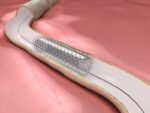Original title: Evaluation of proximal protection devices during carotid artery stenting as the first choice for embolic protection. Reference: Hornung M et al. EuroIntervention. 2014; Epub ahead of print. This series of the Frankfurt CardioVascular Center included 124 consecutive patients undergoing carotid angioplasty with proximal protection. The first 92 patients received the Gore Flow Reversal System (WL Gore;...
Benefits at 5 years of routine invasive strategy in Non-ST-Elevation Acute Coronary Syndromes
Original title: Impact of an invasive strategy on five years outcomein men and women with Non-ST-Elevation Acute Coronary Syndromes. Reference: Joakim Alfredsson et al. Am Heart J. 2014;Epub ahead of print. This meta-analysis included patients with non-ST-elevation acute coronary syndrome (NSTE ACS) from randomized studies FRISC II, ICTUS and RITA 3 and compared the routine invasive strategy...
Superficial Femoral Artery In-Stent Restenosis with Drug Eluting Balloon: 2 Year Follow Up.
Original title: Drug-Eluting Balloons for the Treatment of the Superficial Femoral Artery In-Stent Restenosis. 2-Year Follow-Up. Reference: Vittorio Virga et al. J Am Coll Cardiol Intv 2014;7:411–5. Although the use of the self-expanding nitinol stent has improved angioplasty outcomes in femoropopliteal territory, restenosis remains a challenge still affecting at least 25% of the population in the first year....
Cohort with left main coronary injury of SYNTAX. Final monitoring at 5 years.
Original title: Five-year outcomes in patients with left main disease treated with either percutaneous coronary intervention or coronary artery bypass grafting in the synergy between percutaneous coronary intervention with taxus and cardiac surgery trial. Reference: Morice MC et al. Circulation. 2014 Jun 10;129(23):2388-94. Current guidelines recommend CABG as the strategy of choice for treating lesions of...
Orbital Atherectomy improves calcified lesions treatment outcomes
Original title: Pivotal Trial to Evaluate the Safety and Efficacy of the Orbital Atherectomy System in Treating de Novo, Severely Calcified Coronary Lesions (ORBIT II) Reference: Jeffrey Chambers, et al. JACC Intervention 2014;7:510-8 Severely calcified coronary lesions, traditionally associated to difficult or impossible stent implantation, asymmetric stent expansion, higher post procedural events rate, more restenosis, more lesion revascularization,...
Severe coronary calcification is a predictor of coronary events in acute coronary syndromes
Original title: Ischemic Outcomes After Coronary Intervention of Calcified Vessels in Acute Coronary Syndromes. Pooled Analysis From the HORIZONS and ACUITY Trials. Reference: Philippe Généreux, et al. J Am Coll Cardiol 2014;63:1845-54 Calcification of the arteries has always been a challenge and a generator of problems during coronary angioplasty, but its impact on acute coronary syndromes has not...
The length of the stent is not an event predictor with the new generation of DES. It is the end of the Spot stenting?
Original title: Impact of the Stent Length on Long-Term Clinical Outcomes Following Newer-Generation Drug-Eluting Stent Implantation. Reference: Ik Jun Choi et al. Am J Cardiol 2014;113:457-464. Completely cover the lesion with a sufficiently long stent has been the preferred strategy that emerged from drug-eluting stents (DES). However, for the first-generation DES stent length has been a predictor of...
Endovascular treatment in critical limb ischemia, better permeability with similar mortality and amputation than surgery.
Original title: Comparative effectiveness of endovascular and surgical revascularization for patients with peripheral artery disease and critical limb ischemia. Reference: W. Schuyler Jones et al. American Heart Journal 2014. Epub ahead of print. Critical limb ischemia is the most severe condition affecting patients with peripheral vascular disease. Mortality, morbidity, and costs associated with this condition are...
Stent reestenosis, the only subgroup that benefits from longer double antiaggregation
Original title: Short vs. Long Term Duration of Dual Antiplatelet Therapy in Patients treated for InstentRestenosis. A PRODIGY Trial substudy. Reference: Gianluca Campo el al. J Am CollCardiol, article in press. In the study PRODIGY (Prolonging Dual Antiplatelet Treatment After Grading Stent- Induced Intimal Hyperplasia) we found that the 24 months ratio of dual antiaggregation was not...
Cilostazol reduces restenosis of DES in lesions larger than 40 mm.
Original title: Comparison of Dual Versus Triple Antiplatelet Therapy After Drug-Eluting Stent According to Stent Length (from the Pooled Analysis of DECLARE Trials). Reference: Seung-Whan Lee et al. Am J Cardiol 2013, article in press. Cilostazol, an inhibitor of phosphodiesterase III , associated with aspirin and clopidogrel showed decrease angiographic restenosis both in conventional stents as well as...









